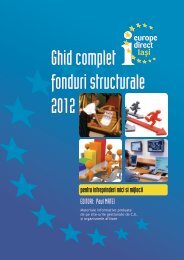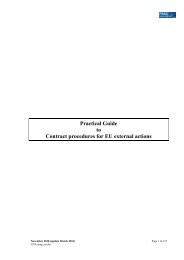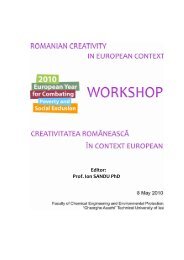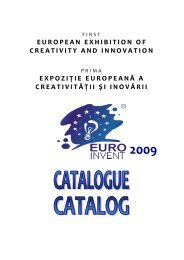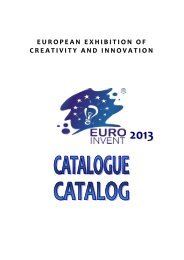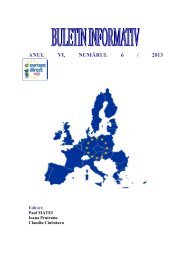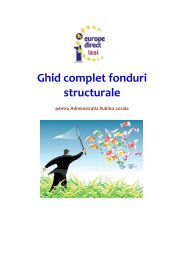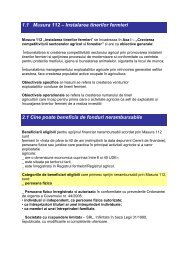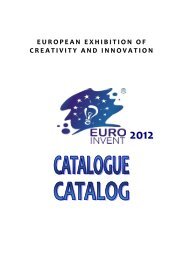2011 - Europe Direct Iasi
2011 - Europe Direct Iasi
2011 - Europe Direct Iasi
Create successful ePaper yourself
Turn your PDF publications into a flip-book with our unique Google optimized e-Paper software.
EUROINVENT <strong>2011</strong><br />
Title Post-doctoral research<br />
Authors Dorina Mantu, Ionel I. Mangalagiu<br />
Institution „Al. I. Cuza” University of <strong>Iasi</strong>, Faculty of Chemistry<br />
Innovation lies in using ultrasounds as a non-conventional<br />
method (environmental friendly) for the synthesis of new<br />
derivatives of 1,2-diazines type 3(2H)-pyridazones, by Nalkylation<br />
reactions. Since N-alkylation reactions under the<br />
action of ultrasound on a nitrogen atom in a heterocycle have<br />
been less studied, and in the class of 3(2H)-pyridazinones have<br />
not been studied, the results are both new and current. Thus, a<br />
comparative study conventional conditions versus ultrasound<br />
irradiation, has made, in order to obtain the desired products<br />
through a more efficient method. In the first stage, starting<br />
Description heterocycles were synthesized (reactants), and then using<br />
reactive halides, were obtained the appropriate 3(2H)pyridazinones<br />
N-substituted.<br />
Using ultrasonic energy has proven to be an effective method of<br />
synthesis for all new compounds obtained. Thus, using<br />
ultrasounds as a promoter of the N-alkylation reactions has<br />
achieved a considerable decrease in reaction times (compared to<br />
classical conditions) and an increase in product yield by 25%.<br />
Since the reaction time was the same for all new compounds<br />
synthesized, we appreciate that this method can be considered to<br />
be general (at least for heterocyclic compounds with 1,2-diazines<br />
structure type 3(2H)-6-phenyl-piridazones N 2 -substituted).<br />
R.24.<br />
Title<br />
Authors<br />
Institution<br />
Description<br />
Research on electrodeposited Zn-Co alloys thin films for<br />
magnetic sensors applications<br />
L. Vlad 1 , A.V. Sandu 2 , M. Dobromir 1 and V. Georgescu 1<br />
1)<br />
Faculty of Physics “Al. I. Cuza” University, <strong>Iasi</strong> 700506,<br />
Romania, 2) Gheorghe Asachi Technical University of <strong>Iasi</strong>, 71<br />
D. Mangeron Blv., 70005, <strong>Iasi</strong>, România<br />
The purpose of our research was to obtain by a cheap<br />
method Zn-Co thin films and to study their morphology and<br />
magnetic properties, in order to find out technological<br />
applications. We report here on the electrodeposition of Zn-Co<br />
alloy of thin films onto a copper substrate, by using an original<br />
bath based on: ZnSO4 x 7H2O, CoSO4 x 7H2O and some<br />
additional substances (H3BO3, NaCl, Na2SO4). The alloy<br />
composition, structure, morphology and the magnetic properties<br />
of the films were strongly dependent on the electrodeposition<br />
parameters, especially on the cathode potential.<br />
Detailed SEM and XPS analyses indicated the presence of zinc<br />
oxide (ZnO) in the samples (both in as-prepared films and after<br />
Innovative Researches<br />
150



